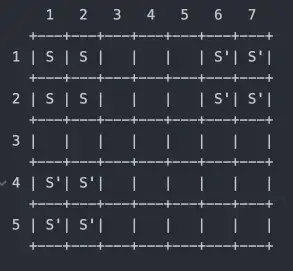Topics
In an m x n grid, to form a rectangle, you need to choose two horizontal lines and two vertical lines from the m+1 horizontal lines and n+1 vertical lines. Thus we have:
A square, on the other hand requires the length and width to be equal. To count the number of squares, you need to consider different sizes: Largest possible square has size: min(m, n). For each size k x k (where k ranges from 1 to min(m, n)), you sum up the number of squares for all possible sizes to get the total number of squares. This can be explained with an example:
Example
Let’s say m = 5, n = 7, and we want to find the number of 2 x 2 squares (so k = 2).
- Horizontal positions: (7 - 2 + 1) = 6
- Vertical positions: (5 - 2 + 1) = 4
- Total 2 x 2 squares: 6 * 4 = 24
You can visualize this. There are 6 places you can slide a 2x2 square horizontally, and 4 places you can slide it vertically. Each combination gives you a unique 2x2 square within the 5x7 grid.
In the figure above, we can see the cells with S denoting the starting position and S’ denoting the max position where we can place the square horizontally and vertically.
Therefore, we can observe that the total number of k x k squares: (m-k+1) * (n-k+1). Summing for all k values, we get:
